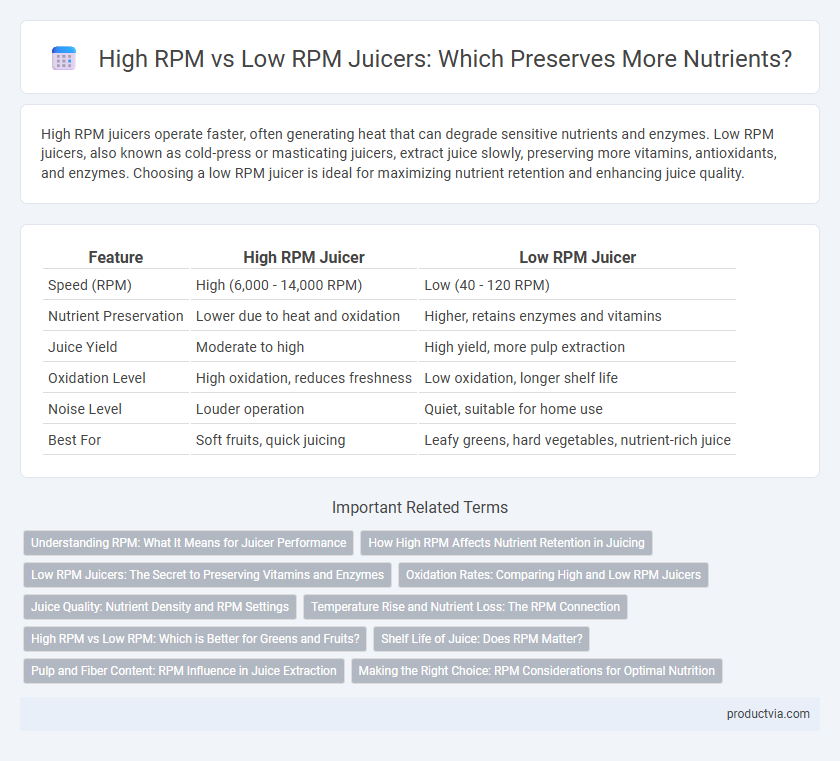High RPM juicers operate faster, often generating heat that can degrade sensitive nutrients and enzymes. Low RPM juicers, also known as cold-press or masticating juicers, extract juice slowly, preserving more vitamins, antioxidants, and enzymes. Choosing a low RPM juicer is ideal for maximizing nutrient retention and enhancing juice quality.
Table of Comparison
| Feature | High RPM Juicer | Low RPM Juicer |
|---|---|---|
| Speed (RPM) | High (6,000 - 14,000 RPM) | Low (40 - 120 RPM) |
| Nutrient Preservation | Lower due to heat and oxidation | Higher, retains enzymes and vitamins |
| Juice Yield | Moderate to high | High yield, more pulp extraction |
| Oxidation Level | High oxidation, reduces freshness | Low oxidation, longer shelf life |
| Noise Level | Louder operation | Quiet, suitable for home use |
| Best For | Soft fruits, quick juicing | Leafy greens, hard vegetables, nutrient-rich juice |
Understanding RPM: What It Means for Juicer Performance
High RPM (revolutions per minute) juicers operate at speeds typically above 6,000 RPM, generating more heat and increasing oxidation, which can reduce nutrient retention in juices. Low RPM juicers, often called slow or cold-press juicers, spin at speeds below 100 RPM, preserving enzymes, vitamins, and minerals by minimizing heat buildup and oxidation. Choosing a low RPM juicer enhances nutrient preservation and juice quality for health-conscious consumers.
How High RPM Affects Nutrient Retention in Juicing
High RPM juicers operate at faster speeds, generating more heat and oxygen exposure that can degrade heat-sensitive nutrients like vitamin C and enzymes. The increased oxidation caused by high rotational speeds reduces the overall nutrient retention compared to slower juicers. While high RPM juicers may extract juice quickly, their impact on nutrient preservation is less effective than low RPM masticating juicers.
Low RPM Juicers: The Secret to Preserving Vitamins and Enzymes
Low RPM juicers operate at slower speeds, significantly reducing heat buildup and oxidation, which helps preserve delicate vitamins and enzymes in fruits and vegetables. This method maintains higher nutrient integrity, ensuring maximum health benefits from your juice. Choosing a low RPM juicer enhances flavor and prolongs the shelf life of fresh juice compared to high-speed alternatives.
Oxidation Rates: Comparing High and Low RPM Juicers
Low RPM juicers operate at slower speeds, significantly reducing oxidation and preserving more nutrients like vitamins C and E, which degrade quickly when exposed to oxygen. High RPM juicers, spinning faster, introduce more air into the juice, accelerating oxidation and causing faster nutrient breakdown. Studies show cold press juicers with RPMs under 100 maintain higher antioxidant levels compared to centrifugal juicers reaching speeds over 10,000 RPM.
Juice Quality: Nutrient Density and RPM Settings
High RPM juicers operate at speeds typically above 10,000 RPM, which generates more heat and oxidation, potentially degrading nutrient density in juice. Low RPM juicers, such as masticating juicers running at 40-100 RPM, minimize heat and oxidation, preserving enzymes, vitamins, and antioxidants for superior juice quality. Optimal RPM settings depend on balancing extraction efficiency with nutrient retention to maximize health benefits and flavor.
Temperature Rise and Nutrient Loss: The RPM Connection
High RPM juicers generate greater heat due to rapid blade movement, causing a significant temperature rise that can degrade heat-sensitive nutrients like vitamin C and enzymes. Low RPM juicers operate at slower speeds, minimizing heat buildup and better preserving antioxidants and phytonutrients essential for optimal health. Controlling RPM is critical for nutrient retention, with slower juicing speeds directly linked to enhanced juice quality and maximum nutrient preservation.
High RPM vs Low RPM: Which is Better for Greens and Fruits?
High RPM juicers operate faster, generating more heat and oxidation, which can degrade delicate nutrients and enzymes in greens and fruits. Low RPM juicers, often called cold press or masticating juicers, preserve more vitamins, antioxidants, and chlorophyll by minimizing heat and exposure to air. For optimal nutrient preservation, especially from leafy greens and soft fruits, low RPM juicers are generally considered superior.
Shelf Life of Juice: Does RPM Matter?
High RPM juicers generate more heat and oxygen during extraction, which can accelerate nutrient degradation and reduce the shelf life of juice to less than 24 hours. Low RPM juicers operate slowly, minimizing heat and oxidation, thereby preserving enzymes and vitamins and extending juice freshness up to 72 hours when properly refrigerated. The preservation of antioxidants and phytonutrients is significantly better in low RPM juices, making them a superior choice for maintaining nutrient quality and shelf stability.
Pulp and Fiber Content: RPM Influence in Juice Extraction
High RPM juicers produce finer pulp with less fiber, leading to smoother juice but potentially lower nutrient retention due to heat and oxidation. Low RPM juicers operate slower, preserving more fiber and nutrients by minimizing heat buildup and oxidation during extraction. The fiber content in juice from low RPM juicers supports better digestion and prolonged nutrient availability.
Making the Right Choice: RPM Considerations for Optimal Nutrition
High RPM juicers generate more heat and oxidation, which can degrade sensitive nutrients like enzymes and vitamins, making them less ideal for nutrient preservation. Low RPM juicers, often called masticating juicers, operate slowly to minimize heat buildup and oxidation, preserving maximum nutrients and enzymes in fruits and vegetables. Choosing a low RPM juicer ensures optimal retention of antioxidants, vitamins, and phytonutrients critical for health benefits.
High RPM vs Low RPM for nutrient preservation Infographic

 productvia.com
productvia.com